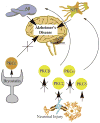Common mechanisms of Alzheimer's disease and ischemic stroke: the role of protein kinase C in the progression of age-related neurodegeneration
- PMID: 25114088
- PMCID: PMC4446718
- DOI: 10.3233/JAD-141422
Common mechanisms of Alzheimer's disease and ischemic stroke: the role of protein kinase C in the progression of age-related neurodegeneration
Abstract
Ischemic stroke and Alzheimer's disease (AD), despite being distinct disease entities, share numerous pathophysiological mechanisms such as those mediated by inflammation, immune exhaustion, and neurovascular unit compromise. An important shared mechanistic link is acute and chronic changes in protein kinase C (PKC) activity. PKC isoforms have widespread functions important for memory, blood-brain barrier maintenance, and injury repair that change as the body ages. Disease states accelerate PKC functional modifications. Mutated forms of PKC can contribute to neurodegeneration and cognitive decline. In some cases the PKC isoforms are still functional but are not successfully translocated to appropriate locations within the cell. The deficits in proper PKC translocation worsen stroke outcome and amyloid-β toxicity. Cross talk between the innate immune system and PKC pathways contribute to the vascular status within the aging brain. Unfortunately, comorbidities such as diabetes, obesity, and hypertension disrupt normal communication between the two systems. The focus of this review is to highlight what is known about PKC function, how isoforms of PKC change with age, and what additional alterations are consequences of stroke and AD. The goal is to highlight future therapeutic targets that can be applied to both the treatment and prevention of neurologic disease. Although the pathology of ischemic stroke and AD are different, the similarity in PKC responses warrants further investigation, especially as PKC-dependent events may serve as an important connection linking age-related brain injury.
Keywords: Alzheimer's disease; blood-brain barrier; immune exhaustion; innate immunity; ischemic stroke; protein kinase C.
Figures



References
-
- Cai HY, Holscher C, Yue XH, Zhang SX, Wang XH, Qiao F, Yang W, Qi JS. Lixisenatide rescues spatial memory and synaptic plasticity from amyloid beta protein-induced impairments in rats. Neuroscience. 2014;277C:6–13. - PubMed
-
- Sutovsky S, Blaho A, Kollar B, Siarnik P, Csefalvay Z, Dragasek J, Turcani P. Clinical accuracy of the distinction between Alzheimer’s disease and frontotemporal lobar degeneration. Bratisl Lek Listy. 2014;115:161–167. - PubMed
-
- Sun MK, Alkon DL. The “memory kinases”: Roles of PKC isoforms in signal processing and memory formation. Prog Mol Biol Transl Sci. 2014;122:31–59. - PubMed
-
- Liu SJ, Gasperini R, Foa L, Small DH. Amyloid-beta decreases cell-surface AMPA receptors by increasing intracellular calcium and phosphorylation of GluR2. J Alzheimers Dis. 2010;21:655–666. - PubMed
Publication types
MeSH terms
Substances
Grants and funding
LinkOut - more resources
Full Text Sources
Other Literature Sources
Medical

